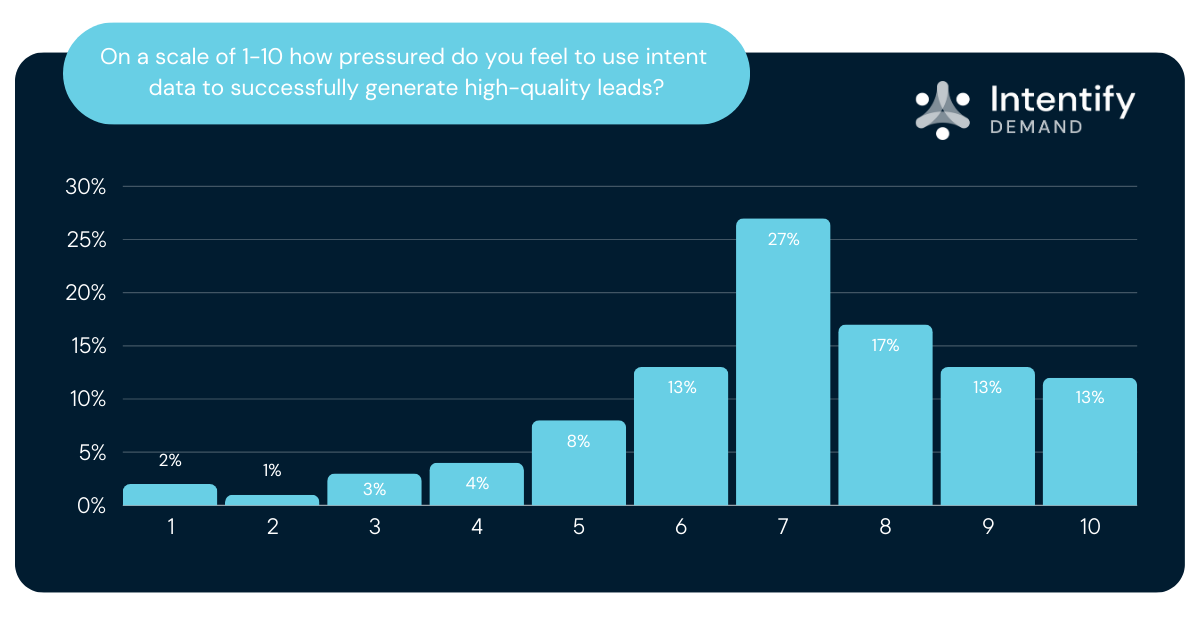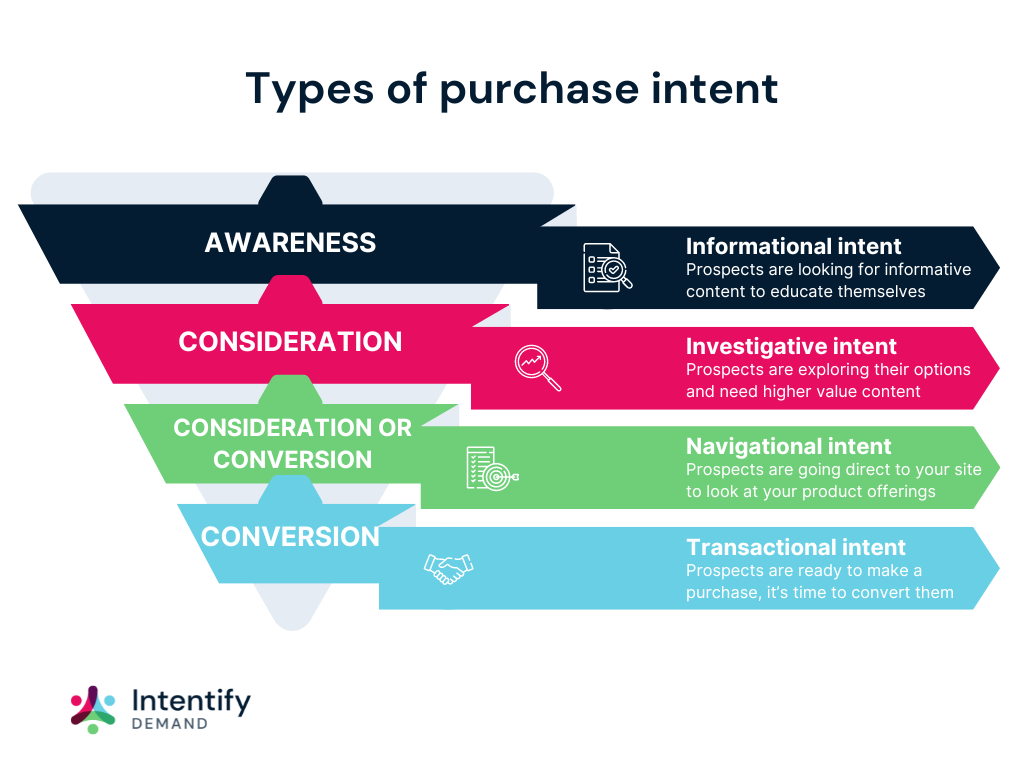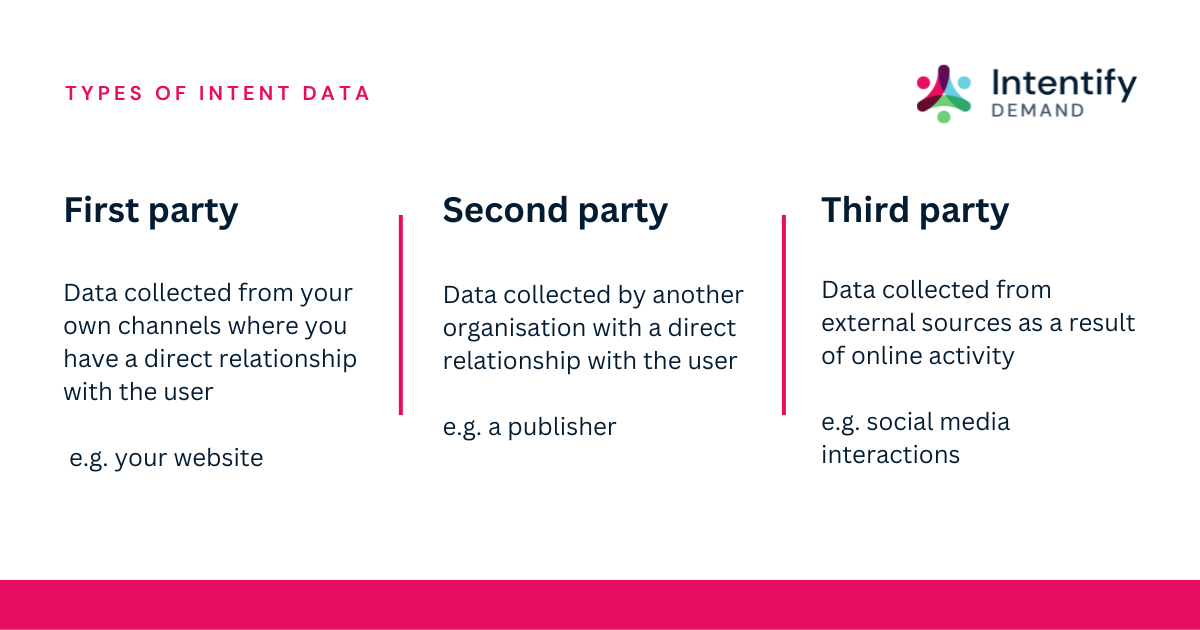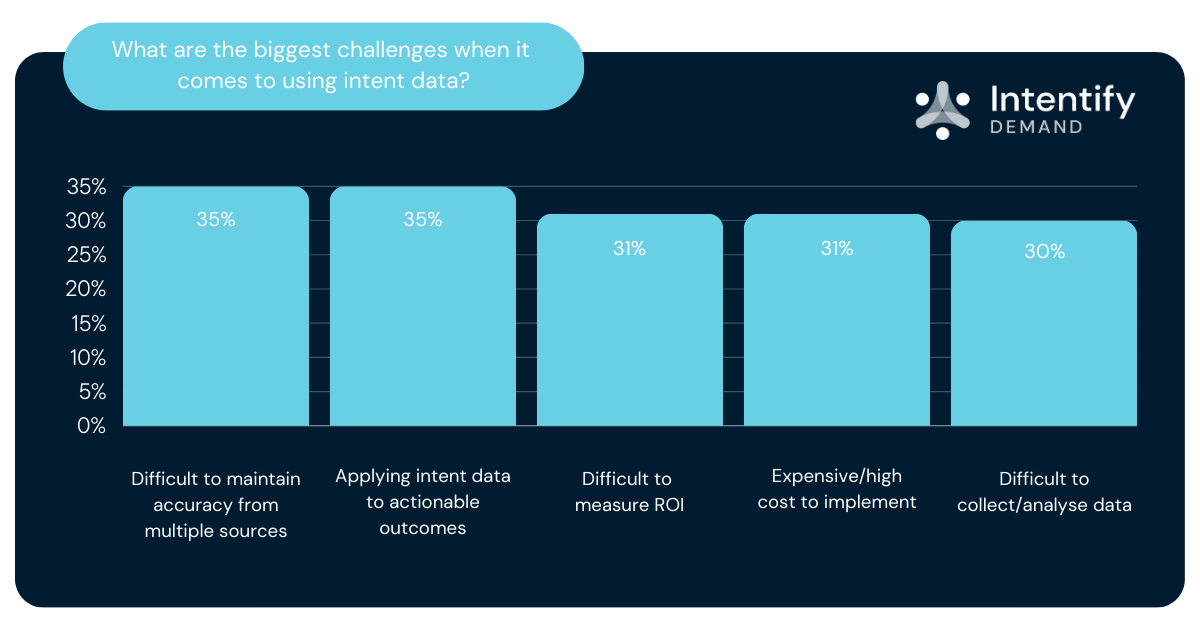Read time: 16 minutes
The B2B buying process is not only becoming more complex but also more competitive.
Although intent data makes it possible to define your target audience, tailor your campaigns and shape your marketing content, this is only possible when it's being utilised effectively.
Still, it’s positive to see that around 40% of businesses are dedicating more than half of their marketing budget to intent data and 70% are planning to increase their spend this year.
And while our latest research found that 98% of B2B marketers say they're confident in their current intent data practices, 37% can’t accurately measure the ROI of their intent data.

This is concerning as marketers are under increasing pressure to demonstrate how valuable intent data is.

If you’ve found yourself in a similar position, you’re in the right place. This article will look at how you can actually use B2B buyer intent data to achieve your marketing goals. And we’ll also get to the heart of intent data ROI to show how you can measure this effectively and prove its value within your marketing strategy. Here's a full outline of what we'll cover:
Where does B2B intent data come from?
As we move around the web, visit different websites, and interact with different content, we all leave a digital footprint. More often than not, these footprints indicate an intent to purchase a service or particular product.
Monitoring and storing these intent signals fuels AI tools that can map out and identify patterns. By understanding these patterns, intent platforms can create predictive models that identify upcoming and future trends based on past online behaviour, and inform businesses who in their target audience is most likely to buy and when.
Recommended reading: Peek inside Pelago: A guided tour on how we create the best leads
There are 4 main types of purchase intent, all of which are generated by different sources:
- Informational intent: when potential buyers are looking to educate themselves
- Investigative intent: when potential buyers are looking for higher value content
- Navigation intent: when prospective buyers are looking at your product offering
- Transactional intent: when a prospective buyer is ready to make a purchase

Taking action in the Zero Moment of Truth (ZMoT)
Of course, your buyers are still human. And as humans, they're not always ready to purchase a solution, even if they're showing strong purchase intent. And this could be down to a number of reasons, most of which are out of their control. It's also important to remember that for many decision makers, the buying process can be long and complex.
In reality, there may be instances where a prospect seems ready to buy and is about to close, yet suddenly drops off the radar; maybe their priorities have changed, maybe their budget has been adjusted, or maybe they moved jobs and no longer need your solution.
There's no linear path to purchase, and with the B2B landscape becoming more competitive and noisier than ever, it's crucial you're in front of the right audience, with your solution, at the exact moment they're experiencing a particular challenge. This is known as the Zero Moment of Truth (ZMoT) and it's the most relevant time to engage your target audience to take action.
Start by defining your objectives
In order to use B2B intent data to your advantage, you first need to clearly define your objectives. This will help you to set, monitor and achieve your marketing goals. You need to decide what you want to focus on. For example, do you want to:
- Increase the volume of leads you generate
- Improve the quality of your leads
- Boost your conversion rates
- Enhance sales outreach
- Expand market reach
You may even hope to achieve all of the above at some stage. But once you have a better understanding of your immediate objectives, you can set SMART goals for your marketing team, and start working towards achieving these goals using intent data.
Choose the right metrics
To determine ROI and whether or not you’re reaching your goals, you need to choose the key performance indicators (KPIs) and metrics that will help you measure your success.
Some of the most relevant metrics might include:
- Conversion rates
- Customer acquisition cost (CAC)
- Customer lifetime value (CLV)
- Revenue attribution
It’s important to choose metrics that correlate with your wider marketing goals and those that will see the biggest influence from your intent data.
Once you know which metrics you'll be measuring, you can then begin to analyse how intent data impacts your KPIs. This might involve A/B testing to isolate and identify the effects of intent data on your marketing efforts.
By understanding the impact intent data has on your campaigns, you can better determine its contribution to your ROI while also fine-tuning how it's used.
Choose the right partners and tools
There are several different ways you can source intent data, including first-party intent data from your own channels, third-party data from external providers and aggregated data from other industry sources.

It's important to choose the right partners and tools to ensure you have access to accurate and up-to-date intent data that aligns with your marketing goals.
Consider partnering with a reliable intent data provider that specializes in B2B data, or ensure any third-party vendors you use for areas such as lead generation or content syndication are leveraging intent data to deliver the most value.
First-party intent data is by far the most valuable, but it's often the hardest to generate. Therefore, accessing someone else's first-party data (and becoming your second-party data) is the next best thing. Not only can it give a big boost to your own first-party data, but it also unlocks a number of different acquisition routes which you may not have. For example, insights from a social platform you're not active on.
However, it's important to ensure the accuracy and validity of second-party data before engaging in any kind of partnership. Look for providers that have a strong reputation, a wide range of intent data sources, and the ability to deliver actionable insights.
In addition to choosing the right partner, you'll also need to invest in the right tools to effectively analyze and utilize the intent data you gather. This could include data management platforms (DMPs), customer relationship management (CRM) systems, marketing automation platforms, and analytics tools.
These tools and platforms can be an important investment and one that has a big impact on your ROI, so take your time at this stage to make sure you introduce the tools and partnerships that will yield the best results.
Segment your audience to target them more effectively
Using insights gathered from intent data, you can segment your audience based on their level of intent and engagement. For example, looking at frequent website visits, content downloads or specific keyword searches to prioritise prospective accounts showing high intent signals.
Recommended reading: Intent signals: The difference between signals and high intent
Try focusing on the topics your prospects are showing an interest in, and segment accordingly. Not only does this allow you to clearly identify key pain points (based on which content they're reading), but it also enables you to foster more meaningful relationships as any follow-up engagement is going to be a lot more relevant.
It's also worth considering how you could use predictive intent to engage with prospects ahead of the curve, when they're in the crucial research and consideration phase (or even earlier!) This is a really strategic way of leveraging intent data and it enables brands to put themselves in front of their ideal target audience before their competitors can.
Consider how to expand your list of relevant prospects
Segmenting the audience you currently have is obviously key, but it's also important to consider how to expand that target account list (TAL) to include relevant accounts you might not have previously considered.
This is when it's time to revisit your ideal customer profile (ICP) and loop in your sales team to track and score high-intent leads from your intent sources, including your website and marketing campaigns (as well as past customers).
Recommended reading: How to build an ideal customer profile for better lead generation results [+ free template]
Leveraging B2B intent data to build an ICP-based list of companies to target, helps you to expand your coverage and reach new buyers, while also discovering contacts who are most interested in your offering. This allows you to focus your marketing and sales efforts on more important areas, such as converting those contacts.
Many of our clients now ask us to build intent-led TALs based on a specific solution, and/or advice on what intent we're seeing across their current TAL so they can make sure the assets they're using in their campaign are relevant.
- El Bryant, Senior Director of Sales
How to lead score with intent data
Lead scoring is a useful technique when it comes to better understanding the behaviours of potential customers and how they interact with your brand. It also enables marketing and sales teams a tangible way to categorise and prioritise leads based on their activity. For example, it provides parameters and rules around when a marketing qualified lead (MQL) becomes a marketing qualified account (MQA) and at exactly what point a contact then converts into a sales qualified lead (SQL) and can be passed along to a sales rep.
Adding intent signals into the mix provides marketers with a quicker way to interpret the behaviour of a potential customer and whether they might be ready to move further down the funnel.
Focus on how to make your intent data actionable
Applying intent data to actionable outcomes was cited as one of the biggest challenges in our latest research.

And the reason why this is often such an issue is because, more often than not, marketers are focusing too much on intent data during the campaign. But there needs to be more consideration around the pre- and post-campaign activities.
Think about your strategy and your targeting
Before a campaign can begin, it's important for marketers to take the time to prep themselves first. We've already mentioned how to use intent data to expand your prospect list, and this is crucial to ensuring the campaign is a success and targeting the right people.
Simply going through the process of building an intent-led TAL opens up the opportunity to learn more about the audience you're targeting. This, in turn, leads into being able to inform the rest of your multichannel activity; such as fine-tuning programmatic targeting, informing content creation and content syndication activities, and tailoring HTML e-sends.
Intent data can be used to enrich an existing TAL, or create an ‘intent-led’ TAL, to really hone in and prioritise the individuals that are most relevant and likely to be in-market for your specific solution. It can also be used to ensure targeting isn’t missing any ‘hotspots’ in terms of geos, industries, company size/revenue, etc.
- El Bryant, Senior Director of Sales
Optimising ongoing campaign activity
Of course, intent data is most useful during a campaign - it just shouldn't be the only focus. The important thing to remember is that intent data is a multi-layered approach with many avenues to explore in terms of making it actionable.
Start with prioritising individuals at the accounts that are showing current and predicted purchase intent. Map these individuals against your priority areas to find the true sweet spot of high value leads.
Intent data should be used to prioritise the individuals showing the highest intent for your specific solution. This not only ensures you’re receiving leads with the highest chance of conversion, but your solution-specific assets are actually relevant to these individuals!
- El Bryant, Senior Director of Sales
Think about how to follow up and nurture
Some believe the end of the campaign is when the hard work begins. Which is definitely true. The nurture and conversion of your prospects is a fine art that needs carefully crafted messaging, relevant and valuable content, and positive brand equity.
Make sure you're targeting and engaging with accounts based on their specific intent, whether that's through a content syndication programme or other channels such as programmatic advertising.
Receiving specific intent keywords alongside every lead can help support a nurture sequence that is further tailored to that individual’s/account’s specific area(s) of interest.
What's more we can take this full circle and further target priority leads generated via content syndication; whether they're showing intent within a priority area, or via multiple engagements, further exposing them to your brand messaging (specific to the associated keyword) with ABM display via our intent-led programmatic solution.
Intent helps not only target the 'who' (which individuals at which accounts) but takes care of the 'with what' - relevant messaging speaking to their specific area of intent.
- El Bryant, Senior Director of Sales
Personalise your content and outreach
One of the biggest advantages of using intent data is the ability to personalize your content and outreach to potential leads. By monitoring intent signals, you can identify the specific needs and interests of your target audience and tailor your messaging accordingly.
The digital space is a constant onslaught of messaging whether that's via email, on social platforms or when using search engines. As a result, it's become incredibly easy for us to tune out the noise, which also means it's easy for relevant prospects to ignore generic emails or online ads.
We delivered 3-5 contacts per company (CPC) for a lead generation campaign, each with different intent keywords. The client was then able to follow-up with relevant messaging and build a case on how their solution solves the problems of multiple people (with different areas of specialism) across the company.
- El Bryant, Senior Director of Sales
Use the intent data you gather to create targeted marketing campaigns that speak directly to the pain points and challenges your ideal customers are facing. Take the time to understand the challenges and current needs of prospective accounts. Make sure to capture their attention with messaging that speaks directly to them. This could include sending personalized emails, creating relevant content, or even offering customized product demos or webinars.
The more you can align your messaging with the specific needs and interests of your prospects, the higher your chance of capturing their attention and driving them towards a purchase decision.
And intent data has the power to make your messaging much more personal. Imagine an email campaign that empathises with your exact situation but instead of diving into a hard sell, it takes the time to constructively guide you towards information that helps you solve your problem. Sounds dreamy, right?
We had a client who provided 3 priority intent topic areas. For every lead we delivered that showed intent in those areas, we delivered a second asset that was relevant to that specific topic area. We were able to nurture and build the relationship of that lead by knowing what they were interested in and delivering on it.
- El Bryant, Senior Director of Sales
Monitor and optimise your strategies
Intent data is not a one-time solution. It requires continuous monitoring and refinement to ensure it remains effective. Regularly review your campaign performance and analyze the impact of intent data on your marketing efforts.
There's also no such thing as a set-and-forget marketing campaign. And no matter what type of campaign you're running, revisiting your metrics to monitor performance and fine-tune is crucial to success.
Adjust your strategies as needed based on the valuable insights you gather. For example, if you notice that certain intent signals are consistently leading to higher conversion rates, focus your efforts on targeting relevant prospects showing those intent signals.
By consistently monitoring and refining your strategies, to identify patterns, trends and opportunities for improvement, you can optimize how you use B2B intent data to achieve better results over time.
This also gives you the opportunity to regularly review and refine your goals, KPIs and metrics to keep driving the business forward.
As you find your feet with intent data, you can then begin to find other ways to make use of it and move you closer to achieving your marketing goals. For example:
- Finding upsell and cross-sell opportunities: Rather than focusing on converting new contacts, monitoring and nurturing current customers for opportunities to upsell or cross-sell is important for customer retention as well as meeting objectives. Look for signals that a customer is researching a new product or service and see if you have an offering that could match their needs.
- Flag customers at risk for churn: No matter how successful you are at closing new deals, potential customer churn is a big problem - one that is ultimately five times more expensive in the long run. Use intent data to identify who might be at risk of churn and then tackle the issue head-on, whatever it may be.
- Create competitive plays: Tracking the online activity of your competitors allows you to quickly identify what their most popular content is, what topics they're focusing on and where they're investing their resources. This will give you a good idea of what working for them. You can then take this information to your sales reps to create competitive plays and target those who are actively researching your competitors.
Implement attribution modelling
In order to understand ROI and which strategies are proving to be the most effective, you need to implement attribution modelling techniques.
These models allow you to attribute conversions and revenue to specific touch-points along the customer journey and give credit to the relevant marketing channels and campaigns, based on their influence on conversion outcomes.
This is one of the best ways to demonstrate the role of intent data in driving conversions and generating revenue.
Make intent data your go-to source
Intent data should be your go-to source when it comes to planning your marketing and sales activities.
By following the advice outlined in this article, you'll be in a strong position to showcase how intent data is improving your ROI and providing actionable insights that really make a difference. Data visualisations such as charts, graphs and dashboards can go a long way in helping to demonstrate exactly how intent is helping you to achieve your marketing goals.
Once you've managed to successfully integrate intent data into your marketing activities, the next question to ask yourself is: how else can I use intent data?
Read next: 7 simple ways you can use intent data in your marketing campaigns this year




